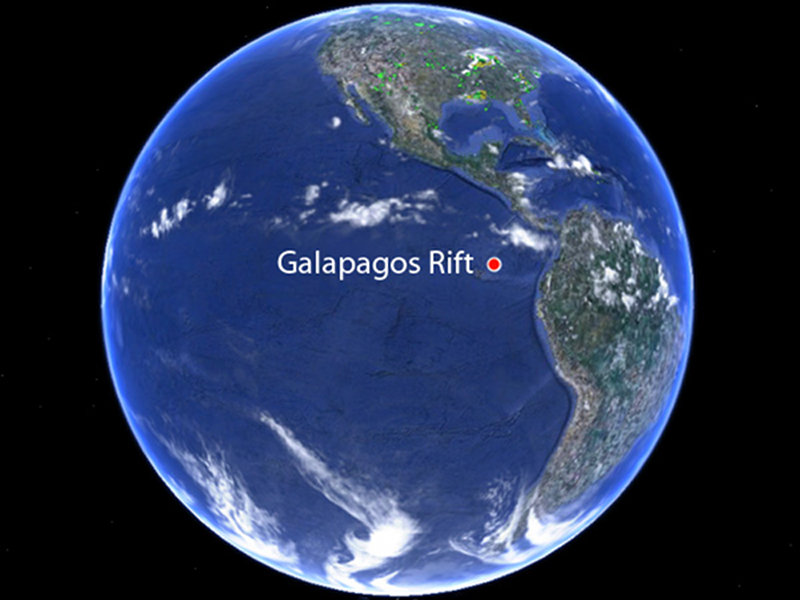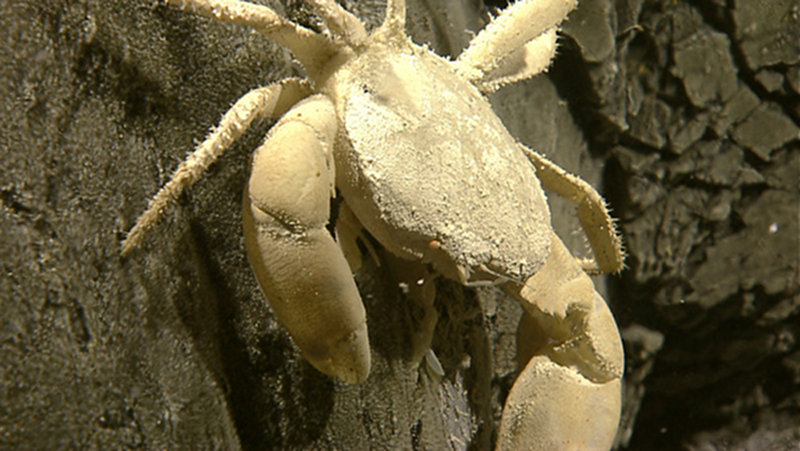
By Bob Embley, Geophysicist - NOAA Pacific Marine Environmental Laboratory
July 18, 2011
This video shows microbial mats and plumes of vent gases and 'flock' (floating white blobs of bacteria) at a diffuse venting site, found on the third ROV dive of the expedition. Video courtesy of NOAA Office of Ocean Exploration and Research, Galapágos Rift Expedition 2011. Download (mp4, 17.0 MB).
We know when and where most of the volcanic eruptions have been on the Earth’s land surface for the past several decades. Seen from space in a sort of time-lapse movie, one can imagine each eruption as a small light of varying duration as Earth spins through time and space. However, we could only put a few “lights” on the 70% of the Earth’s surface covered by the oceans because most of the seafloor is optically invisible to satellites and other remote sensing devices that provide monitoring of the Earth’s land surface.

The Galapagos Rift makes up a tiny portion (86-89 W longitude) of the Mid-Ocean Ridge, a global chain of rarely-seen volcanic activity. Image courtesy of NOAA Office of Ocean Exploration and Research. Download image (jpg, 79 KB).
The area we’ve been looking at over the past few days is a small site along the globe-encircling chain of volcanoes called the Mid-Ocean Ridge. This “seam” is where new ocean crust is “born” as molten rock intrudes in long thin dikes, spreading apart the ocean crust and often erupting onto the seafloor. The birth is accompanied by venting of nutrient rich fluids that feed a rapid growth of microbial communities followed by colonization of higher level chemosynthetic organisms such as the giant tubeworms and clams found on the Galapagos Ridge. We know there are frequent eruptions along the Mid-Ocean Ridge but we can only put a time and date on the few that we’ve serendipitously come across or monitored with fixed hydrophones (underwater microphones) in a few small areas. Sometimes we see indication of seafloor spreading events (or their immediate aftermath) by detecting the warm and turbid plumes rising up into the water column. This is what attracted us to the sites we are now exploring on the seafloor.

Diffuse venting areas, such as this one found on an early dive, host unique microbial communities fueled by nutrients contained in the escaping hydrothermal fluids. Image courtesy of NOAA Office of Ocean Exploration and Research. Download larger version (jpg, 1.3 MB).
This strong connection between oceanography, biology and geology makes mid-ocean ridge research and exploration a nexus for strong collaboration between these diverse disciplines. Using clues from the water column surveys and the seafloor geologic and biologic observations, we are trying to piece together a scientific puzzle. Over the first few dives at Area 2A we saw two sites separated by ~9 miles with young lavas and intense “diffuse” venting with only a few mobile species that are “vent specific”. Did an eruption (or eruptions) occur here in the recent past? Are the few species we saw at the warm water vents the pioneers of a new generation of lush vent communities or will the heat dissipate before the colonizing larvae “find” the site? As scientists making a new set of observations, we quickly form a hypothesis to explain the data. Already there are several being developed for the site but it’s also clear that we’ll need more information to home in on the most likely one. At this preliminary stage of interpretation we believe that the eruption (or eruptions) occurred very recently and that it would have appeared as a brief flash of light on our time-lapse movie of the past few decades of Earth’s volcanic activity.

A Brachyuran crab rests on rock near a site of diffused venting. These blind crabs are typically found inhabiting mussel beds close to hydrothermal activity. Image courtesy of NOAA Office of Ocean Exploration and Research. Download larger version (jpg, 1.5 MB).